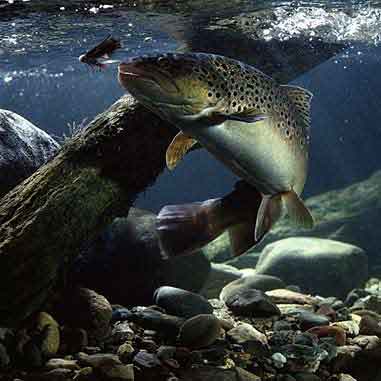I moved to the Kennebec Valley to open a fly shop 10 years ago, when the fishery was thriving. Now it is a mere shadow of its former self.
Once the most written-about fishery in Maine — arguably, all of New England — the Kennebec even failed to make a recent top-10 list put out by the newspaper.
By now, it is fairly common knowledge that a problem at the hatchery compromised this once-marquee fishery. Specifically, the brown trout were inbred to a point where it affected their survival and growth rates. Numbers dropped off, as did size.
The problems were spelled out for Chandler Woodcock, new commissioner of the Department of Inland Fisheries & Wildlife, at a meeting in The Forks. He was made aware of the internal documents he would need to read to validate the position that genetics, not dams, rainbow trout, floods, effluent, etc., had caused the decline of this invaluable resource.
Documents included a University of Montana at Missoula study, in which the browns are referred to as having a “surprising lack of genetic diversity”; notes from the Coldwater Working Group that refer to the browns as “severely inbred”; and the Brown Trout Management Plan, which references a possible genetic problem.
The DIF&W’s brown trout strain was in trouble as early as 2001. A decade later, some progress has been made but our most important brown trout waters still have not been addressed. This problem affected the Kennebec River in Waterville, Shawmut, Skowhegan, Madison and Solon. It also affected the Androscoggin River from Gilead to Bethel, as well as the Sheepscot River.
The effect on the Kennebec region is obvious. A decade ago, there were fly shops in Bath, Shawmut, Norridgewock, Madison and Solon. Today, there is only one; and it too is for sale. Tourism in the region has dropped off significantly. Guides have moved to other rivers; my fly shop now guides more than three-quarters of our trips outside the area.
In acknowledgment of this problem and under pressure to do something about it, the DIF&W purchased brown trout brood stock from Connecticut and Massachusetts a few years ago. Unfortunately, officials are refusing to stock them above Shawmut or in the upper Androscoggin. They claim to be studying the new fish, but any studies will be ineffective because of mixed-year classes, uneven numbers and no fin-clips.
The loss of the Kennebec brown trout fishery hurt anglers and businesses. It also hurt the DIF&W because the loss of license sales, especially the temporary nonresident licenses associated with the former guiding business and tourism.
It costs as much to stock a good fish as it does a bad fish, so there is no rational reason that this has gone on as long as it has.
In fairness, Woodcock did not create this problem, but he is now fully aware of it and has the documents that support it. He can meet with his staff and challenge them to explain what, if anything, has been done to address the problems pointed out in the early 2000s. He can bring in outside experts to validate or discredit the conclusions.
Fixing the brown trout problem is one of the few things that Woodcock can do that has no cost attached to it. It requires no messy public hearings or rule-making procedures. It does not affect the regulations book. There will be no opposition outside of the few in the DIF&W who still believe something other than genetics is behind the collapse of Maine’s brown trout fisheries. This is a simple policy decision, and Woodcock can make it. Let’s hope he does.
Robert Mallard is owner of Kennebec River Outfitters, Madison.
Send questions/comments to the editors.



Success. Please wait for the page to reload. If the page does not reload within 5 seconds, please refresh the page.
Enter your email and password to access comments.
Hi, to comment on stories you must . This profile is in addition to your subscription and website login.
Already have a commenting profile? .
Invalid username/password.
Please check your email to confirm and complete your registration.
Only subscribers are eligible to post comments. Please subscribe or login first for digital access. Here’s why.
Use the form below to reset your password. When you've submitted your account email, we will send an email with a reset code.